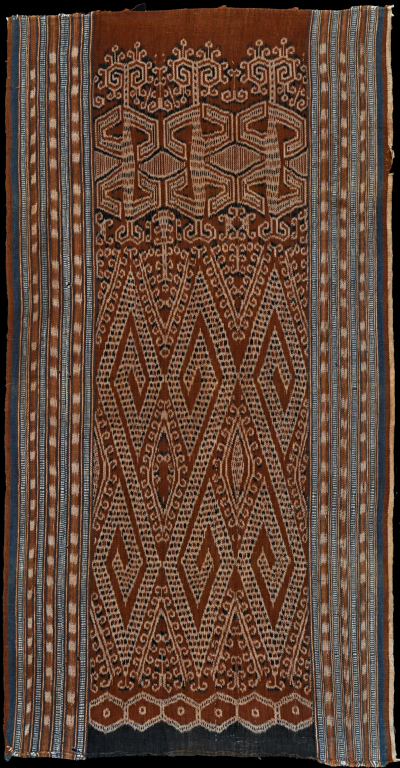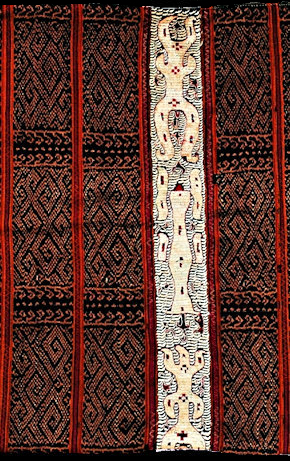| |
 
 | | | |
242 Borneo, Kalimantan
Kain kebat (skirt cloth)  
| | Locale: | Desa people | | Period: | 19th to early 20th c. | | Yarn: | Cotton, hand-spun, medium. Unusual single weft. | | Technique: | Warp ikat | | Panels: | 1 | | Size: | 66 x 127 cm (2' 1" x 4' 2") LW: 1.92 | | Weight: | 270 g (9.5 oz), 322 g/m2 (1.06 oz/ft2) | | Design: | Skirt decorated with ikat patterning in dark brown, rust-red and ecru . The distinctive tripartite division of the field is a characteristic of Desa (and Ketungau) designs. Another hallmark of this region is a number of hexagons arranged in one or more rows. The main motif is leku Nengali motif: a coiled mythological snake turning around to look for prey. This motif is used by several Ibanic groups, with only slightly varying mythological associations. The upper third of the cloth has rounded double rhombs. All of the main motifs are set off by tiny coils. The borders have 3 simple ikat strips, separated by ribbed lines of warp-faced float weave in blue and white. The field is also tripartite longitudinally, three identical sections having been put together in LR-RL-LR order. | | Comment: | The reverence for the number three, sacred to all Ibanic peoples, is manifest in the vertical as well as the horizontal division of the field and in the three dotted longitudinal border stripes. Such borders are characteristic for the Desa people. In those from the Ketungau river basin (such as PC 212 and 300), the stripes are so elaborate that the dots are hardly recognisable as such. The brownish tone indicates that it was dyed with engkerbai rather than engkudu. Very good condition for its age. A few tiny holes, not affecting the aesthetic enjoyment. This cloth was made in very unusual single weft. | | Background: | Chapters on Borneo and Kalimantan. | | Published: | Ikat Textiles of the Indonesian Archipelago, 2018.
| | Compare: | 212 220 229 300 243 | | Sources: | Leku Nengali identified in Heppell, The Seductive Warp Thread, p. 121. Similar to that of 19 th C. kain kebat in Amann, Textiles from Borneo, Fig. 88; also similar to that of Desa skirt in Heppell, The Seductive Warp Thread, but more artistically 'clever': partly superimposed rather than simply juxtaposed, as is also done on a Baleh pua on Fig. 139. Michael Heppell identifies this cloth as from the Desa tribe - not from the Senangan, who ikat in the same style, but do not use the leku Nengali motif. Very similar to example in East Indies Museum IDN 10-291-111, and one in collection Krzysztof Musial, B04. Curiously, a tapis from the Paminggir people (Lampung, Sumatra) in the Mingei International Museum (Acc. nr. 1992-19-040) shows practically the same patterning, see fragment below.
 | | |

©Peter ten Hoopen, 2025
All rights reserved.
|
|


